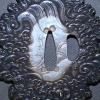-
Posts
802 -
Joined
-
Last visited
-
Days Won
3
Content Type
Profiles
Forums
Events
Store
Downloads
Gallery
Posts posted by Katsujinken
-
-
Has this ever been translated?
-
This wouldn't be the first time that we have seen a fake Koson origami on Aoi (if it is in fact fake)...
-
That feeling that travels up your spine as you carefully remove a 700 year old piece of history from its shirasaya; something that survived wars and peace; something that shouldn't still exist but miraculously still does, thanks to generations of care.
Whew, just had to get that out there!
(Runner up goes to the sound a great two piece habaki makes when you click it together.)
-
 3
3
-
-
Ray, not sure where in CT he is, but there is a New York Token Kai meeting tomorrow.
-
Thanks Ray! Perhaps in the end the boshi will be the key here, but we are obviously already well beyond my expertise. :-)
-
Interesting. So what do you get when you have this blade with chikei, suguha, and a tight[er] nioiguchi? Does the hamon rule out Norishige? Maybe we're seeing an utsushimono of some kind?
-
The hada has tons of character, but I don't see any chikei to speak of in the photos. Of course that could be due to the photos or my inexperience. The nioi-guchi also looks quite clear to me, which pulls this further away from Norishige. This is super interesting though, and I'd love to know the results of shinsa when the time comes. Either way it seems your courage will be rewarded!
-
 2
2
-
-
Markus Sesko provides excellent translation services for very reasonable fees. I can happily recommend him from personal experience.
-
That shot of Norishige’s work is something I have not seen this before so different cant wait to see the whole blade

Comin' right up: http://www.nihonto.ca/norishige-8/
-
Any idea when this will be released more widely? Would love to see it.
-
 1
1
-
-
-
When it comes to nihonto on eBay, the only thing you're bidding on (if you don't know the seller) is trouble.
-
 3
3
-
-
How old is your blade, Henry? For blades of a certain age, some ware are to be expected and overall health is what matters. The younger a blade gets, the less acceptable flaws/health issues become. And it's also a personal choice.
I'm not interested in a Shinto or younger blade that's not flawless, but that's just me. Whereas a truly flawless Koto blade – if you can even find one – will cost a small fortune. These blades were made without technology – folding was the only way to achieve the necessary purity. They are ingenious, but almost none are truly flawless.
In the end, different strokes for different folks.
Bear in mind that polishing can reveal flaws as well as fix them. I'm familiar with that passage from the Connoissuers Guide, and I think it's important to place any ware in context – who made the blade, when, what has it been through, historical significance, overall health, etc.
-
I believe that is what it says (肥前國忠吉).
I'll let the experts weigh in on the rest of your query.
-
Yeah, half baked is exactly how I'd describe it.
-
With the usual caveat that I'm no expert, you might find this article helpful: https://www.bloomberg.com/news/articles/2016-12-14/house-republicans-plan-for-a-tax-revolution-quicktake-q-a
From what I understand, such a tax/tariff/whatever would be targeted at corporations and not individuals sending or receiving goods. So my *guess* is that should such a measure come to pass some nihonto "transactions" might be affected while others would not. For example, I would not expect private shipments between agents for shinsa to be affected. Also I think that private transactions logically might be exempt whereas goods meant for resale within the US are really the target here.
Then again, we're essentially talking about unique pieces of art, not an item for which there is an equivalent option already inside US borders.
So... who knows.
Sorry, this probably wasn't all that helpful! ¯\_(ツ)_/¯
-
I wanted that tsuba too!

-
They're not very conducive to display, but the additional peace of mind is more than worth it. Thanks everyone.
-
Enlightening! Thank you Brian.
-
I love this board.
-
 1
1
-
-
Ah yes, Yagyu Ryu is one of the schools known for doing this, but I had no idea there were extant koshirae that we could refer to. Very cool.
-
Hi folks,
I'm curious if anyone here has ever seen any evidence of menuki being "reversed" (so they settle into the palms and not the fingers when the tsuka is gripped).
It's a not uncommon choice among sword practitioners of certain styles today, and some claim it has a historical basis and improves grip and sensitivity.
Nakamura Taizaburo writes that the standard placement today – what he calls the Edo style – came about after the need for combat subsided, but that prior to that the menuki were in opposite positions as described above.
What say you, fine NMBers? Is there any historical evidence?
-
 1
1
-
-
-



Koto/shinto Fujishiro's Nihon Jiten For Sale On Ebay- Buy It Now
in Auctions and Online Sales or Sellers
Posted
Is this his website? Is the information here up to date? http://pages.suddenlink.net/afuresearch/afu/index.htm
This page looks like it hasn't been touched since about 1994. :-)